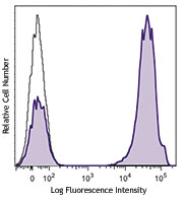-
Sign In
-

-
 Sony Biotechnology
Sony Biotechnology
-

-
 Sony Biotechnology
Sony Biotechnology
Brilliant Violet 421™ anti-human CD3
Antibodies Single
Sony
UCHT1
Flow Cytometry
Mouse IgG1, κ
Human
2102170
$399.00
Description
CD3ε is a 20 kD chain of the CD3/T-cell receptor (TCR) complex which is composed of two CD3ε, one CD3γ, one CD3δ, one CD3ζ (CD247), and a T-cell receptor (α/β or γ/δ) heterodimer. It is found on all mature T cells, NKT cells, and some thymocytes. CD3, also known as T3, is a member of the immunoglobulin superfamily that plays a role in antigen recognition, signal transduction, and T cell activation.
Formulation
Phosphate-buffered solution, pH 7.2, containing 0.09% sodium azide and BSA (origin USA).Recommended Usage
Each lot of this antibody is quality control tested by immunofluorescent staining with flow cytometric analysis. For flow cytometric staining, the suggested use of this reagent is ≤5 microL per million cells or 5 microL per 100 microL of whole blood. It is recommended that the reagent be titrated for optimal performance for each application.
Brilliant Violet 421™ excites at 405 nm and emits at 421 nm. The standard bandpass filter 450/50 nm is recommended for detection. Brilliant Violet 421™ is a trademark of Sirigen Group Ltd.
This product is subject to proprietary rights of Sirigen Inc. and is made and sold under license from Sirigen Inc. The purchase of this product conveys to the buyer a non-transferable right to use the purchased product for research purposes only. This product may not be resold or incorporated in any manner into another product for resale. Any use for therapeutics or diagnostics is strictly prohibited. This product is covered by U.S. Patent(s), pending patent applications and foreign equivalents.
References
1. Salmeron A, et al. 1991. J. Immunol. 147:3047. (IP)
2. Graves J, et al. 1991. J. Immunol. 146:2102. (Activ)
3. Lafont V, et al. 2000. J. Biol. Chem. 275:19282. (Activ)
4. Ryschich E, et al. 2003. Tissue Antigens 62:48. (IHC)
5. Thompson AG, et al. 2004. J. Immunol. 173:1671. (Activ)
6. Sakkas LI, et al. 1998. Clin. Diagn. Lab. Immun. 5:430. (IHC)
7. Mack CL, et al. 2004. Pediatr. Res. 56:79. (IHC)
8. Thakral D, et al. 2008. J. Immunol. 180:7431. (FC) PubMed
9. Van Dongen JJM, et al. 1988. Blood 71:603. (WB)
10. Yoshino N, et al. 2000. Exp. Anim. (Tokyo) 49:97. (FC)
11. Pollard, K. et al. 1987. J. Histochem. Cytochem. 35:1329. (IHC)
12. Luckashenak N, et al. 2013. J. Immunol. 190:27. PubMed.


